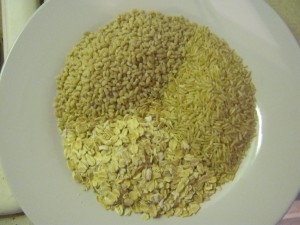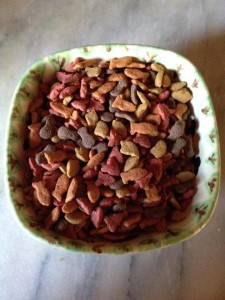Written by Beth Laubenthal, January 2014.
This article is the third in a series of four focused on the pet food industry manufacturing process. This one discusses the formation of the pet food industry and its evolution. The others are, The Origins of the Pet Food Industry, AAFCO: Their labeling requirements and the “Rules”, and finally, Decoding Kibble: The Ingredients. None of this is intended to frighten anyone. The objective is to educate people, arming them with the information they need to make better food choices for their pets. If these articles are of any value to you, I hope you will share them and “pay it forward” for other pet owners!
 In the previous article, I left off by saying this:
In the previous article, I left off by saying this:
Lastly, the most mystifying part of the labeling requirements: the ingredient list. At first glance, it is easy to read. It’s simply a list of ingredients found in the pet food. When looked at closely, it can be very confusing to understand what the ingredients actually are and what their purpose is in the food. The order in which ingredients appear on a pet food label are by weight: the heaviest ingredients are listed first.
Before we can understand how and why the ingredients appear in the order that they do, we need to know what our government allows to be rendered, how the rendering process works and how pet food is made. Once we understand that, we can then look at the AAFCO’s pet food ingredient definitions with a clearer understanding of how they are made and what they actually are.
The manufacturing of pet food starts outside of the pet food plants. It starts in the rendering factories.
According to the EPA (Environmental Protection Agency), a government agency, sources of raw materials collected by rendering plants include “butcher shops, supermarkets, restaurants, fast-food chains, poultry processors, slaughterhouses, farms, ranches, feedlots, and animal shelters.” Generally, these sources are considered unfit for human consumption.
Raw materials from butcher shops and supermarkets can include expired meats, spoiled meats and trim. Restaurants and fast-food chains supply used grease in addition to unwanted meats. Materials from poultry processors and slaughterhouses can include leftovers from the meat industry such as offal, skin, blood, bones and fetuses, among other things. They can also include raw materials that farms, ranches and feedlots also supply. Raw materials from these places can include 4D animals, among other things. What are 4D animals? These are animals that are disease, disabled, dying or dead. They are considered unfit for human consumption and are not allowed in the meat market. Lastly, some animal shelters provide raw material to rendering plants.
There is quite a bit of controversy about euthanized pets being used in pet food. The EPA allows euthanized pet carcasses to be used in rendering plants. Currently, there is no law banning the use of euthanized pets in pet food.
In the 1990’s, the FDA sampled pets foods for traces of phenobarbital, the drug commonly used to euthanize cats and dogs. The FDA’s Centers for Veterinary Medicine (CVM) found trace amounts of the drugs in samples of pet food. They also sampled the pet foods for traces of cat and dog DNA, finding none. They concluded that “the source of the phenobarbital in dog food is cattle or horses euthanized and then rendered” and that the low amount of phenobarbital “dogs might receive through food are unlikely to cause them any adverse health effects.” The FDA noted that no further research was needed.
What the CVM failed to realize is that heat destroys DNA. When organic matter is heated, it goes through a “denaturing” process. Denaturing of DNA occurs at its melting point (denoted by the term “Tm”). It involves the strand of DNA separating. “The melting point (Tm) is the temperature at which half the DNA is unwound. DNA that consists entirely of AT base pairs melts at about 70°c (158°f)and DNA that has only G/C base pairs melts at over 100°c (212°f).”
Raw materials delivered to rendering plants are processed at temperatures between 240°f and 280°f for 40 to 90 minutes. The cooking temperatures are high enough to destroy DNA of any animal material rendered. However, phenobarbital is not destroyed.
In a 1998 interview with a Washington television news station, former AAFCO president Herschel Pendell says, in response to being asked if there is a law against the use of euthanized pets in pet food, “Technically, it may not be acceptable, but it is still protein.” When asked if a consumer could tell if the pet food they are buying contains euthanized pets by just looking at the label, he replied, “There’s no real way to tell that because if the ingredient says ‘meat and bone meal,’ you do not know if that is cattle, or sheep, or horse, or Fluffy.”
Now that we know the sources for the raw material for pet food, to understand what the ingredients are in pet food and why they are there, we need to know how the rendering process works and how kibble is made
The Rendering Process: From the Plant to Your Store Shelves
 Now, we are going to look at how kibble is made, starting at the rendering plant. In order to keep things simple, we will only look at the solids (versus liquid fats).
Now, we are going to look at how kibble is made, starting at the rendering plant. In order to keep things simple, we will only look at the solids (versus liquid fats).
Materials (raw meats, animal carcasses) that arrive to the rendering plants are stored in bins. They are taken to a conveyor belt where they pass under a strong magnet that pulls out any metal fragments or objects (such as dog tags). The materials are then dumped into the grinder where they are processed to get uniformed size.
After being measured, the ground material is cooked at 240f (115.5c) to 280f (137.7c) for about 90 minutes in a device known as the “Continuous Cooker.” As discussed in the last post, at this temperature, DNA is destroyed. During the cooking process, moisture is evaporated. Fats and meats are separated from bone.
The mixture leaves the Continuous Cooker on the Drainage Conveyor. The Conveyor separates more of the liquid fats from the mixture. After a trip on the Drainage Conveyor, the mixture is then sent to Screw Presses, which removes an additional 10 – 12 percent of the liquid fat from the product. From the Screw Press, the solids are sent to the Press Fat Conveyor where the remaining liquid fat is extracted. The materials (know known as “meal”) are sent to the Press Solid Conveyor where they are readied for shipment to the pet food manufacturer.
The fats extracted from this are processed a couple of more times before being shipped off. Fats from the rendering process are also used, along with a host of chemical flavorings, to coat the kibble.
At the pet food manufacturing plant, the pressed meal that came from the rendering plant, along with grains and other dry ingredients are ground up again. They are incorporated with wet ingredients, forming a dough. The next step is “PreConditioning” where liquid fats are added into the dough and the dough is exposed to steam and heat. This is a very important step as it starts the cooking process.
From the PreConditioning step, the dough faces more heat and more pressure as it enters the extruder (introduced by Purina around 1956 for the use in the pet food manufacturing process). After leaving the extruder, the kibble is sent into an oven where it dries.
Depending on the manufacturer, the kibble will either be cooled and then sprayed with a slurry of fats, chemical flavor enhancers and vitamins or it will be sprayed and then cooled. Without the slurry of fats, chemical flavor enhancers and vitamins, not only would our pets not eat the food, the food would have no nutritional value as the immense cooking kibble under goes destroys all nutrients.
After cooling and being sprayed with the mixture, the kibble is sent to packaging. From packaging, it goes to your favorite store where it has a shelf life of at least a year (some up to 18 months) if unopened or 4 – 6 weeks if the bag is opened. Without the processes to turn the raw meats into dry kibble, raw materials would last less than a day without spoilage if kept in the same condition as kibble (no refrigeration needed).
If you enjoyed this article or found it informative, please “Like” it, “Tweet” it, or share it using any of the buttons below. And don’t forget to check out our FB page, join the discussions in our awesome FB group and follow us on Twitter!
Created 02/17/14; Updated 08/11/14

